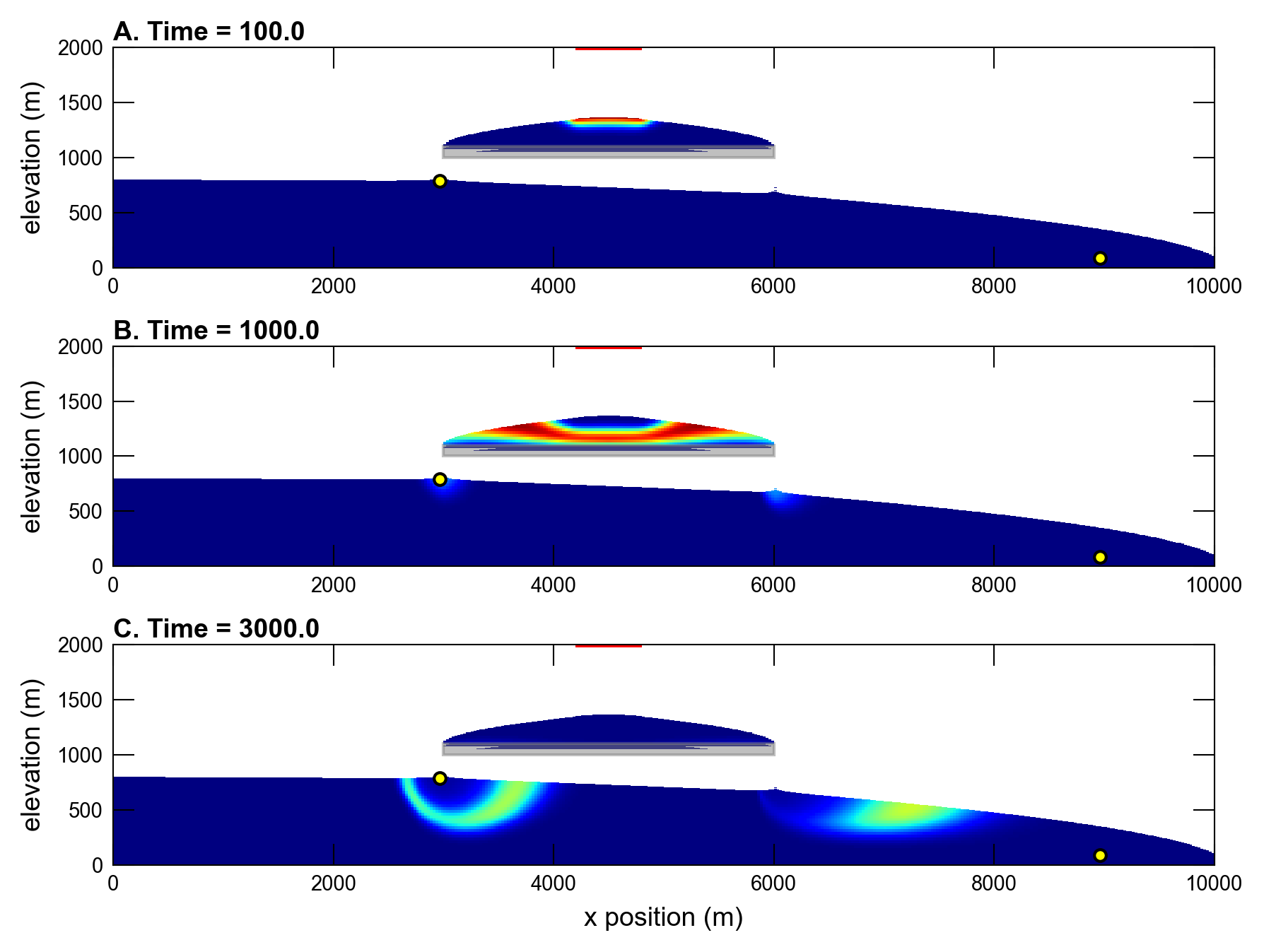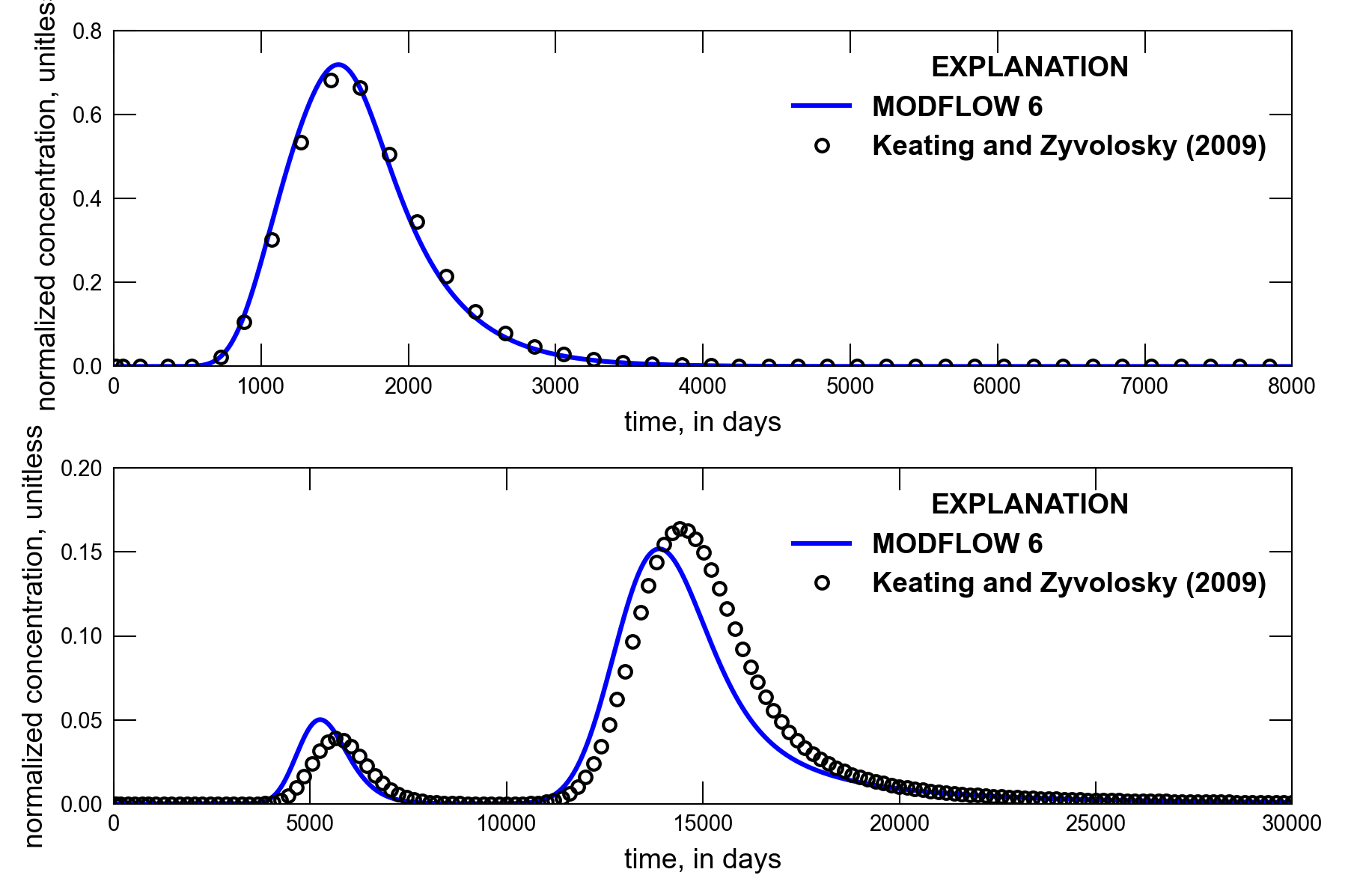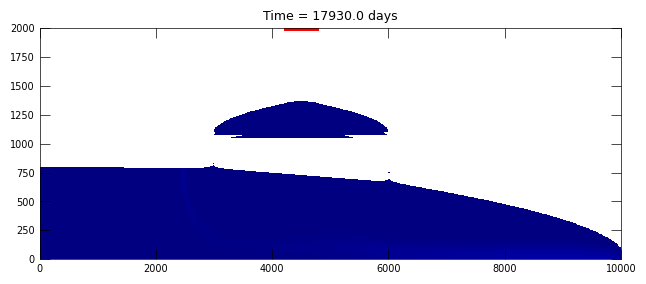This page was generated from
ex-gwt-keating.py.
It's also available as a notebook.
Keating Problem
This problem uses a two-dimensional cross-section model to simulate a perched aquifer overlying a water table aquifer. The presence of a discontinuous low permeability lens causes the perched aquifer to form in response to recharge. The problem also represents solute transport through the system.
Initial setup
Import dependencies, define the example name and workspace, and read settings from environment variables.
[1]:
import os
import pathlib as pl
import flopy
import git
import matplotlib.patches
import matplotlib.pyplot as plt
import numpy as np
import pooch
from flopy.plot.styles import styles
from modflow_devtools.misc import get_env, timed
# Example name and workspace paths. If this example is running
# in the git repository, use the folder structure described in
# the README. Otherwise just use the current working directory.
sim_name = "ex-gwt-keating"
try:
root = pl.Path(git.Repo(".", search_parent_directories=True).working_dir)
except:
root = None
workspace = root / "examples" if root else pl.Path.cwd()
figs_path = root / "figures" if root else pl.Path.cwd()
data_path = root / "data" / sim_name if root else pl.Path.cwd()
# Settings from environment variables
write = get_env("WRITE", True)
run = get_env("RUN", True)
plot = get_env("PLOT", True)
plot_show = get_env("PLOT_SHOW", True)
plot_save = get_env("PLOT_SAVE", True)
gif_save = get_env("GIF", True)
Define parameters
Define model units, parameters and other settings.
[2]:
# Model units
length_units = "meters"
time_units = "days"
# Model parameters
nlay = 80 # Number of layers
nrow = 1 # Number of rows
ncol = 400 # Number of columns
delr = 25.0 # Column width ($m$)
delc = 1.0 # Row width ($m$)
delz = 25.0 # Layer thickness ($m$)
top = 2000.0 # Top of model domain ($m$)
bottom = 0.0 # Bottom of model domain ($m$)
hka = 1.0e-12 # Permeability of aquifer ($m^2$)
hkc = 1.0e-18 # Permeability of aquitard ($m^2$)
h1 = 800.0 # Head on left side ($m$)
h2 = 100.0 # Head on right side ($m$)
recharge = 0.5 # Recharge ($kg/s$)
recharge_conc = 1.0 # Normalized recharge concentration (unitless)
alpha_l = 1.0 # Longitudinal dispersivity ($m$)
alpha_th = 1.0 # Transverse horizontal dispersivity ($m$)
alpha_tv = 1.0 # Transverse vertical dispersivity ($m$)
period1 = 730 # Length of first simulation period ($d$)
period2 = 29270.0 # Length of second simulation period ($d$)
porosity = 0.1 # Porosity of mobile domain (unitless)
obs1 = (49, 1, 119) # Layer, row, and column for observation 1
obs2 = (77, 1, 359) # Layer, row, and column for observation 2
obs1 = tuple([i - 1 for i in obs1])
obs2 = tuple([i - 1 for i in obs2])
seconds_to_days = 24.0 * 60.0 * 60.0
permeability_to_conductivity = 1000.0 * 9.81 / 1.0e-3 * seconds_to_days
hka = hka * permeability_to_conductivity
hkc = hkc * permeability_to_conductivity
botm = [top - (k + 1) * delz for k in range(nlay)]
x = np.arange(0, 10000.0, delr) + delr / 2.0
plotaspect = 1.0
# Fill hydraulic conductivity array
hydraulic_conductivity = np.ones((nlay, nrow, ncol), dtype=float) * hka
for k in range(nlay):
if 1000.0 <= botm[k] < 1100.0:
for j in range(ncol):
if 3000.0 <= x[j] <= 6000.0:
hydraulic_conductivity[k, 0, j] = hkc
# Calculate recharge by converting from kg/s to m/d
rcol = []
for jcol in range(ncol):
if 4200.0 <= x[jcol] <= 4800.0:
rcol.append(jcol)
number_recharge_cells = len(rcol)
rrate = recharge * seconds_to_days / 1000.0
cell_area = delr * delc
rrate = rrate / (float(number_recharge_cells) * cell_area)
rchspd = {}
rchspd[0] = [[(0, 0, j), rrate, recharge_conc] for j in rcol]
rchspd[1] = [[(0, 0, j), rrate, 0.0] for j in rcol]
Model setup
Define functions to build models, write input files, and run the simulation.
[3]:
def build_mf6gwf():
print(f"Building mf6gwf model...{sim_name}")
name = "flow"
sim_ws = os.path.join(workspace, sim_name, "mf6gwf")
sim = flopy.mf6.MFSimulation(sim_name=name, sim_ws=sim_ws, exe_name="mf6")
tdis_ds = ((period1, 1, 1.0), (period2, 1, 1.0))
flopy.mf6.ModflowTdis(
sim, nper=len(tdis_ds), perioddata=tdis_ds, time_units=time_units
)
flopy.mf6.ModflowIms(
sim,
print_option="summary",
complexity="complex",
no_ptcrecord="all",
outer_dvclose=1.0e-4,
outer_maximum=2000,
under_relaxation="dbd",
linear_acceleration="BICGSTAB",
under_relaxation_theta=0.7,
under_relaxation_kappa=0.08,
under_relaxation_gamma=0.05,
under_relaxation_momentum=0.0,
backtracking_number=20,
backtracking_tolerance=2.0,
backtracking_reduction_factor=0.2,
backtracking_residual_limit=5.0e-4,
inner_dvclose=1.0e-5,
rcloserecord="0.0001 relative_rclose",
inner_maximum=100,
relaxation_factor=0.0,
number_orthogonalizations=2,
preconditioner_levels=8,
preconditioner_drop_tolerance=0.001,
)
gwf = flopy.mf6.ModflowGwf(
sim, modelname=name, save_flows=True, newtonoptions=["newton"]
)
flopy.mf6.ModflowGwfdis(
gwf,
length_units=length_units,
nlay=nlay,
nrow=nrow,
ncol=ncol,
delr=delr,
delc=delc,
top=top,
botm=botm,
)
flopy.mf6.ModflowGwfnpf(
gwf,
save_specific_discharge=True,
save_saturation=True,
icelltype=1,
k=hydraulic_conductivity,
)
flopy.mf6.ModflowGwfic(gwf, strt=600.0)
chdspd = [[(k, 0, 0), h1] for k in range(nlay) if botm[k] < h1]
chdspd += [[(k, 0, ncol - 1), h2] for k in range(nlay) if botm[k] < h2]
flopy.mf6.ModflowGwfchd(
gwf,
stress_period_data=chdspd,
print_input=True,
print_flows=True,
save_flows=False,
pname="CHD-1",
)
flopy.mf6.ModflowGwfrch(
gwf,
stress_period_data=rchspd,
auxiliary=["concentration"],
pname="RCH-1",
)
head_filerecord = f"{name}.hds"
budget_filerecord = f"{name}.bud"
flopy.mf6.ModflowGwfoc(
gwf,
head_filerecord=head_filerecord,
budget_filerecord=budget_filerecord,
saverecord=[("HEAD", "ALL"), ("BUDGET", "ALL")],
)
return sim
def build_mf6gwt():
print(f"Building mf6gwt model...{sim_name}")
name = "trans"
sim_ws = os.path.join(workspace, sim_name, "mf6gwt")
sim = flopy.mf6.MFSimulation(
sim_name=name,
sim_ws=sim_ws,
exe_name="mf6",
continue_=True,
)
tdis_ds = ((period1, 73, 1.0), (period2, 2927, 1.0))
flopy.mf6.ModflowTdis(
sim, nper=len(tdis_ds), perioddata=tdis_ds, time_units=time_units
)
flopy.mf6.ModflowIms(
sim,
print_option="summary",
outer_dvclose=1.0e-4,
outer_maximum=100,
under_relaxation="none",
linear_acceleration="BICGSTAB",
rcloserecord="1000.0 strict",
inner_maximum=20,
inner_dvclose=1.0e-4,
relaxation_factor=0.0,
number_orthogonalizations=2,
preconditioner_levels=8,
preconditioner_drop_tolerance=0.001,
)
gwt = flopy.mf6.ModflowGwt(sim, modelname=name, save_flows=True)
flopy.mf6.ModflowGwtdis(
gwt,
length_units=length_units,
nlay=nlay,
nrow=nrow,
ncol=ncol,
delr=delr,
delc=delc,
top=top,
botm=botm,
)
flopy.mf6.ModflowGwtic(gwt, strt=0)
flopy.mf6.ModflowGwtmst(gwt, porosity=porosity)
flopy.mf6.ModflowGwtadv(gwt, scheme="upstream")
flopy.mf6.ModflowGwtdsp(
gwt, xt3d_off=True, alh=alpha_l, ath1=alpha_th, atv=alpha_tv
)
pd = [
("GWFHEAD", "../mf6gwf/flow.hds", None),
("GWFBUDGET", "../mf6gwf/flow.bud", None),
]
flopy.mf6.ModflowGwtfmi(gwt, flow_imbalance_correction=True, packagedata=pd)
sourcerecarray = [
("RCH-1", "AUX", "CONCENTRATION"),
]
flopy.mf6.ModflowGwtssm(gwt, sources=sourcerecarray)
saverecord = {
0: [
("CONCENTRATION", "STEPS", 10),
("CONCENTRATION", "LAST"),
("CONCENTRATION", "FREQUENCY", 10),
],
1: [
("CONCENTRATION", "STEPS", 27, 227),
("CONCENTRATION", "LAST"),
("CONCENTRATION", "FREQUENCY", 10),
],
}
flopy.mf6.ModflowGwtoc(
gwt,
budget_filerecord=f"{name}.cbc",
concentration_filerecord=f"{name}.ucn",
concentrationprintrecord=[
("COLUMNS", ncol, "WIDTH", 15, "DIGITS", 6, "GENERAL")
],
saverecord=saverecord,
printrecord=[
("CONCENTRATION", "LAST"),
(
"BUDGET",
"ALL",
),
],
)
obs_data = {
f"{name}.obs.csv": [
("obs1", "CONCENTRATION", obs1),
("obs2", "CONCENTRATION", obs2),
],
}
flopy.mf6.ModflowUtlobs(gwt, digits=10, print_input=True, continuous=obs_data)
return sim
def build_models():
sim_mf6gwf = build_mf6gwf()
sim_mf6gwt = build_mf6gwt()
sim_mf2005 = None # build_mf2005()
sim_mt3dms = None # build_mt3dms(sim_mf2005)
return sim_mf6gwf, sim_mf6gwt, sim_mf2005, sim_mt3dms
def write_models(sims, silent=True):
sim_mf6gwf, sim_mf6gwt, sim_mf2005, sim_mt3dms = sims
sim_mf6gwf.write_simulation(silent=silent)
sim_mf6gwt.write_simulation(silent=silent)
@timed
def run_models(sims, silent=True):
sim_mf6gwf, sim_mf6gwt, sim_mf2005, sim_mt3dms = sims
success, buff = sim_mf6gwf.run_simulation(silent=silent)
assert success, buff
success, buff = sim_mf6gwt.run_simulation(silent=silent)
assert success, buff
Plotting results
Define functions to plot model results.
[4]:
# Figure properties
figure_size = (7.5, 3)
def plot_results(sims):
print("Plotting model results...")
plot_head_results(sims)
plot_conc_results(sims)
plot_cvt_results(sims)
if plot_save and gif_save:
make_animated_gif(sims)
def plot_head_results(sims):
print("Plotting head model results...")
sim_mf6gwf, _, _, _ = sims
gwf = sim_mf6gwf.flow
botm = gwf.dis.botm.array
with styles.USGSMap():
sim_ws = sim_mf6gwf.simulation_data.mfpath.get_sim_path()
head = gwf.output.head().get_data()
head = np.where(head > botm, head, np.nan)
fig, ax = plt.subplots(1, 1, figsize=figure_size, dpi=300, tight_layout=True)
pxs = flopy.plot.PlotCrossSection(model=gwf, ax=ax, line={"row": 0})
pa = pxs.plot_array(head, head=head, cmap="jet")
pxs.plot_bc(ftype="RCH", color="red")
pxs.plot_bc(ftype="CHD")
plt.colorbar(pa, shrink=0.5)
confining_rect = matplotlib.patches.Rectangle(
(3000, 1000), 3000, 100, color="gray", alpha=0.5
)
ax.add_patch(confining_rect)
ax.set_xlabel("x position (m)")
ax.set_ylabel("elevation (m)")
ax.set_aspect(plotaspect)
if plot_show:
plt.show()
if plot_save:
sim_folder = os.path.split(sim_ws)[0]
sim_folder = os.path.basename(sim_folder)
fname = f"{sim_folder}-head.png"
fpth = figs_path / fname
fig.savefig(fpth)
def plot_conc_results(sims):
print("Plotting conc model results...")
sim_mf6gwf, sim_mf6gwt, _, _ = sims
gwf = sim_mf6gwf.flow
gwt = sim_mf6gwt.trans
botm = gwf.dis.botm.array
with styles.USGSMap():
head = gwf.output.head().get_data()
head = np.where(head > botm, head, np.nan)
sim_ws = sim_mf6gwt.simulation_data.mfpath.get_sim_path()
cobj = gwt.output.concentration()
conc_times = cobj.get_times()
conc_times = np.array(conc_times)
fig, axes = plt.subplots(3, 1, figsize=(7.5, 4.5), dpi=300, tight_layout=True)
xgrid, _, zgrid = gwt.modelgrid.xyzcellcenters
# Desired plot times
plot_times = [100.0, 1000.0, 3000.0]
nplots = len(plot_times)
for iplot in range(nplots):
print(f" Plotting conc {iplot + 1}")
time_in_pub = plot_times[iplot]
idx_conc = (np.abs(conc_times - time_in_pub)).argmin()
totim = conc_times[idx_conc]
ax = axes[iplot]
pxs = flopy.plot.PlotCrossSection(model=gwf, ax=ax, line={"row": 0})
conc = cobj.get_data(totim=totim)
conc = np.where(head > botm, conc, np.nan)
pa = pxs.plot_array(conc, head=head, cmap="jet", vmin=0, vmax=1.0)
pxs.plot_bc(ftype="RCH", color="red")
pxs.plot_bc(ftype="CHD")
confining_rect = matplotlib.patches.Rectangle(
(3000, 1000), 3000, 100, color="gray", alpha=0.5
)
ax.add_patch(confining_rect)
if iplot == 2:
ax.set_xlabel("x position (m)")
ax.set_ylabel("elevation (m)")
title = f"Time = {totim}"
letter = chr(ord("@") + iplot + 1)
styles.heading(letter=letter, heading=title, ax=ax)
ax.set_aspect(plotaspect)
for k, i, j in [obs1, obs2]:
x = xgrid[i, j]
z = zgrid[k, i, j]
ax.plot(
x,
z,
markerfacecolor="yellow",
markeredgecolor="black",
marker="o",
markersize="4",
)
if plot_show:
plt.show()
if plot_save:
sim_folder = os.path.split(sim_ws)[0]
sim_folder = os.path.basename(sim_folder)
fname = f"{sim_folder}-conc.png"
fpth = figs_path / fname
fig.savefig(fpth)
def make_animated_gif(sims):
import copy
import matplotlib as mpl
from matplotlib.animation import FuncAnimation, PillowWriter
print("Animating conc model results...")
sim_mf6gwf, sim_mf6gwt, _, _ = sims
gwf = sim_mf6gwf.flow
gwt = sim_mf6gwt.trans
botm = gwf.dis.botm.array
# load head
with styles.USGSMap() as fs:
head = gwf.output.head().get_data()
head = np.where(head > botm, head, np.nan)
# load concentration
cobj = gwt.output.concentration()
conc_times = cobj.get_times()
conc_times = np.array(conc_times)
conc = cobj.get_alldata()
# set up the figure
fig = plt.figure(figsize=(7.5, 3))
ax = fig.add_subplot(1, 1, 1)
pxs = flopy.plot.PlotCrossSection(
model=gwf,
ax=ax,
line={"row": 0},
extent=(0, 10000, 0, 2000),
)
cmap = copy.copy(mpl.cm.get_cmap("jet"))
cmap.set_bad("white")
nodata = -999.0
a = np.where(head > botm, conc[0], nodata)
a = np.ma.masked_where(a < 0, a)
pc = pxs.plot_array(a, head=head, cmap=cmap, vmin=0, vmax=1)
pxs.plot_bc(ftype="RCH", color="red")
pxs.plot_bc(ftype="CHD")
def init():
ax.set_title(f"Time = {conc_times[0]} days")
def update(i):
a = np.where(head > botm, conc[i], nodata)
a = np.ma.masked_where(a < 0, a)
a = a[~a.mask]
pc.set_array(a.flatten())
ax.set_title(f"Time = {conc_times[i]} days")
# Stop the animation at 18,000 days
idx_end = (np.abs(conc_times - 18000.0)).argmin()
ani = FuncAnimation(fig, update, range(1, idx_end), init_func=init)
writer = PillowWriter(fps=25)
fpth = figs_path / "{}{}".format(sim_name, ".gif")
ani.save(fpth, writer=writer)
def plot_cvt_results(sims):
print("Plotting cvt model results...")
_, sim_mf6gwt, _, _ = sims
gwt = sim_mf6gwt.trans
with styles.USGSMap():
sim_ws = sim_mf6gwt.simulation_data.mfpath.get_sim_path()
mf6gwt_ra = gwt.obs.output.obs().data
dt = [("totim", "f8"), ("obs", "f8")]
fname = "keating_obs1.csv"
fpath = pooch.retrieve(
url=f"https://github.com/MODFLOW-USGS/modflow6-examples/raw/master/data/{sim_name}/{fname}",
fname=fname,
path=data_path,
known_hash="md5:174c5548c3bbb9ea4ebc8b5a33ea2851",
)
obs1ra = np.genfromtxt(fpath, delimiter=",", deletechars="", dtype=dt)
fname = "keating_obs2.csv"
fpath = pooch.retrieve(
url=f"https://github.com/MODFLOW-USGS/modflow6-examples/raw/master/data/{sim_name}/{fname}",
fname=fname,
path=data_path,
known_hash="md5:8de2ef529a2537ecd6c62bc207b67fb5",
)
obs2ra = np.genfromtxt(fpath, delimiter=",", deletechars="", dtype=dt)
fig, axes = plt.subplots(2, 1, figsize=(6, 4), dpi=300, tight_layout=True)
ax = axes[0]
ax.plot(
mf6gwt_ra["totim"],
mf6gwt_ra["OBS1"],
"b-",
alpha=1.0,
label="MODFLOW 6",
)
ax.plot(
obs1ra["totim"],
obs1ra["obs"],
markerfacecolor="None",
markeredgecolor="k",
marker="o",
markersize="4",
linestyle="None",
label="Keating and Zyvolosky (2009)",
)
ax.set_xlim(0, 8000)
ax.set_ylim(0, 0.80)
ax.set_xlabel("time, in days")
ax.set_ylabel("normalized concentration, unitless")
styles.graph_legend(ax)
ax = axes[1]
ax.plot(
mf6gwt_ra["totim"],
mf6gwt_ra["OBS2"],
"b-",
alpha=1.0,
label="MODFLOW 6",
)
ax.plot(
obs2ra["totim"],
obs2ra["obs"],
markerfacecolor="None",
markeredgecolor="k",
marker="o",
markersize="4",
linestyle="None",
label="Keating and Zyvolosky (2009)",
)
ax.set_xlim(0, 30000)
ax.set_ylim(0, 0.20)
ax.set_xlabel("time, in days")
ax.set_ylabel("normalized concentration, unitless")
styles.graph_legend(ax)
if plot_show:
plt.show()
if plot_save:
sim_folder = os.path.split(sim_ws)[0]
sim_folder = os.path.basename(sim_folder)
fname = f"{sim_folder}-cvt.png"
fpth = figs_path / fname
fig.savefig(fpth)
Running the example
Define and invoke a function to run the example scenario, then plot results.
[5]:
def scenario(silent=True):
sim = build_models()
if write:
write_models(sim, silent=silent)
if run:
run_models(sim, silent=silent)
if plot:
plot_results(sim)
scenario()
Building mf6gwf model...ex-gwt-keating
<flopy.mf6.data.mfstructure.MFDataItemStructure object at 0x7f677bc3c8b0>
Building mf6gwt model...ex-gwt-keating
<flopy.mf6.data.mfstructure.MFDataItemStructure object at 0x7f677bc3c8b0>
run_models took 47806.91 ms
Plotting model results...
Plotting head model results...

Plotting conc model results...
Plotting conc 1
Plotting conc 2
Plotting conc 3

Plotting cvt model results...

Animating conc model results...
/tmp/ipykernel_6375/2191501162.py:145: MatplotlibDeprecationWarning: The get_cmap function was deprecated in Matplotlib 3.7 and will be removed two minor releases later. Use ``matplotlib.colormaps[name]`` or ``matplotlib.colormaps.get_cmap(obj)`` instead.
cmap = copy.copy(mpl.cm.get_cmap("jet"))
